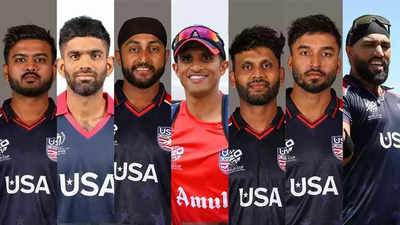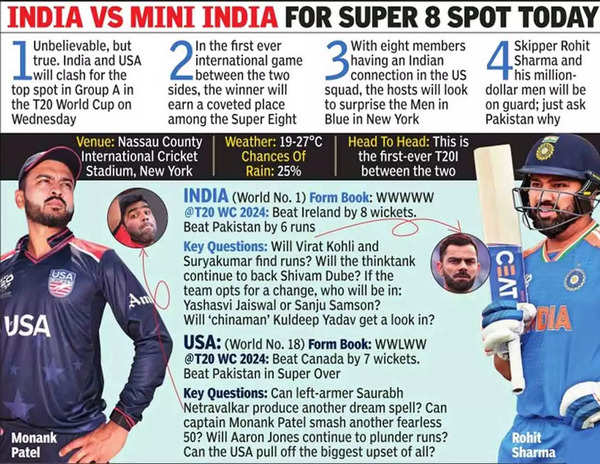
Monank Patel, Saurabh Netravalkar, Harmeet Singh, Nosthush Kenjige, Milind Kumar, Nitish Kumar, Jaspreet Singh
Fledgling cricket nation attracted talent by offering $50k contracts to play, develop and nurture the game
When India take the field on Wednesday, there will be some familiar faces in the USA camp. For example,
Suryakumar Yadav
will square up against his age-group Mumbai teammate Saurabh Netravalkar, while
Rishabh Pant
will have a chance to catch up with Delhi's
Milind Kumar
, who has seen Pant grow at the Sonnet Club.
T20 WORLD CUP: SCHEDULE | POINTS TABLE
USA's competitive show in the ongoing T20 World Cup - which has seen them become surprise table-toppers with India - has caught everyone's attention.
This
American cricket dream
started taking shape in 2020-21. While the squad still has players like Netravalkar, who started out as amateurs in the US circuit, it was the influx of professionals through
Major League Cricket
(MLC) and mushrooming local tournaments that raised the level of cricket.
This was despite the infrastructure being nowhere close to professional standards. "In 2020-21, a lot of us who were still playing first-class cricket in our respective countries were offered contracts by MLC to move to the USA and earn a living as cricket professionals," Milind told TOI from New York.

Milind, who hit a century for Delhi on his Ranji Trophy debut in 2011, had recorded the highest number of runs in a Ranji season while playing for Sikkim after falling out of favour with Delhi. He now represents the
Texas Super Kings
team in the MLC.
The likes of Unmukt Chand, Harmeet Singh and New Zealand's Smit Patel also moved at the same time. Corey Anderson from New Zealand and Sami Aslam from Pakistan were other big names to also shift base.
For these cricketers, it was a jump into the unknown. MLC was yet to be launched. They were allotted teams in different states to play in the
Minor League Cricket
. The deal was simple. They were awarded visas on terms that they would be working for the development of cricket in the US. The base price of a contract was $50,000 a year.
"We work at academies around the country. When we are not playing, we are coaching. Most of the kids have origins in the Indian subcontinent. We are not allowed to take up any other job. This is our job. When we moved here, we never thought about playing a World Cup for USA. But things happened and we have enjoyed our time here," Milind said.
Professionalism is still a distant goal. The minor league is played in makeshift grounds which are mostly public parks. There is no concept of a coaching staff in those teams and playing XIs are largely picked by the promoters of the clubs.
How did this competitive edge come into their cricket, which saw them rout Bangladesh in the lead up to the World Cup before defeating Pakistan? Milind laughed: "We know these Pakistani players very well. We play with them."
He added: "A lot of short private tournaments are played here. The promoters have been bringing active international cricketers like Mohammed Amir,
Azam Khan
, Shai Hope, Oshane Thomas and Martin Guptill to play in these tournaments for a few years. Playing with international players is not new to us. Azam is a good friend. We have learned so much from them."
According to Milind, there's now a certain awareness about the sport. Cricket gear and equipment is easily available, curators around the country have started understanding the art of making a pitch. But he asserted that there's no culture of pleasing the bigger names to get into the USA team.
"Even Anderson has had to earn his spot. Aslam, who had played for Pakistan, was not picked because he didn't perform as well. The country has just two stadiums but it seems like a good beginning," Milind said.









 English (US) ·
English (US) ·